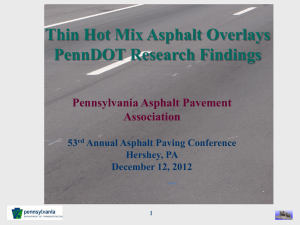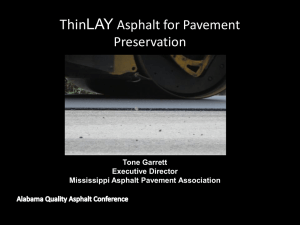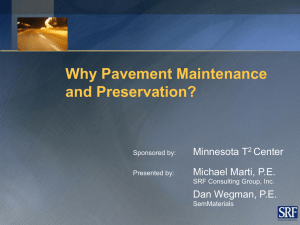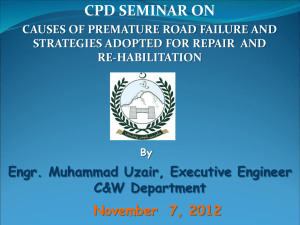Pavement Preservation II:
advertisement
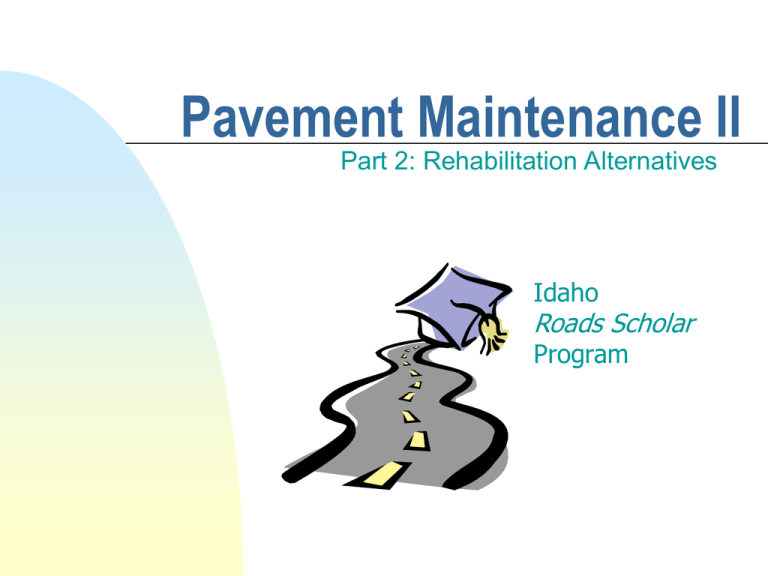
Pavement Maintenance II Part 2: Rehabilitation Alternatives Idaho Roads Scholar Program Objectives Review use of paving fabrics with thick AC overlays, Explore thin hot mix overlays, Investigate cold in-place recycling, and Discuss full depth reclamation. When to Rehabilitate? Rough road, Excessive pavement distress, Loss of skid resistance, Excessive maintenance needs, Inadequate structure for planned use. Rehabilitation Alternatives Thick overlay with paving fabric, Thin overlay, Cold in place recycle (CIR), Full depth reclamation. Paving Fabrics Paving Fabric Basics Keeps water out of the base and subgrade Provides support to retard reflection of existing cracks and distresses Controls evaporation over the longterm, keeping uniform moisture content in the subgrade. How does it work? AC Overlay Fabric Existing AC Pavement Base or Subgrade Selection Considerations Can provide strength up to equivalent of 1.0 inch of AC (if pavement is stable and fabric is properly installed) Cost of fabric (based on DOT studies) is about the same as 0.5 inches of AC Application Considerations Not suitable for severely distressed pavements. Generally not suitable where there is inadequate base/subgrade support. Do not use where free water problems exist. Construction Considerations Minimum overlay thickness when using a fabric is 1.5 inches. Major contributor to failure is lack of tack and/or uniformity of tack coat application. Read manufacturer’s literature for detailed instructions. Sample Products 1/4 inch What is a “Thin” HMA Overlay? 3/8 inch Overlay 1.5” 1/2 inch Why Thin Hot Mix Overlays? Restores Serviceability Low Initial Cost & Life Cycle Cost Minimal Road User Delays/Impacts Adds Structure Reduces Noise Cost Comparison of Pavement Treatments Treatment Life, years Fog seal 1-2 Slurry seal 3-5 Chip seal 4-7 Thin HMA O’lay 10 - 15 Cost ($/yd2) 0.25 - 0.35 0.85 - 1.00 0.90 - 1.20 2.50 - 3.50 Construction Issues Structurally Sound Pavement Section Surface Preparation Correct Localized Weak Areas Clean Surface/Adequate Tack Laydown Time Available for Compaction is Reduced Breakdown Must Stay Close to Paver Need a structurally sound pavement for compaction... Correct localized areas... Surface Preparation Tack Coats Applied to bound surface Light application of asphalt emulsion (0.03-0.07 gal/sy residual asphalt) Example materials SS-1,1h CSS-1,1h Tack Coat Application Uniform application? Time avail. for Compaction, min Mix Temp. = 275F 90F 60F 30F 30 30 20 20 10 10 0 0 1 2 3 Compacted Thickness, in 4 Temperature is Critical > 185ºF Compaction-Lift/Layer Thickness 1/2 inch Dense Mixes 1 to 1 1/2 inch Thick Lift 3/8 inch Mixes 3/4 to 1 inch Thick Lift ½ inch Open Mixes 1 inch Thick Lift Thinner lift loses heat fast! Compaction Equipment For all types of rollers, the primary compaction variables that can be controlled during the rolling process are: Roller speed Number of roller passes Rolling zone Rolling pattern Easy does it! Thin Overlays: Rules of Thumb Pre-level rutted areas Minimum lift thickness is 1 1/2” Roll while mix is hot (>185ºF) Minimum of 3 passes Introduction to Cold In-Place Recycling Milling Machine Crusher Mixer-Paver Advantages Reduced cost of construction Conservation of aggregate and binders Preservation of existing pavement geometrics Hauling Costs Minimized Minimal Air Quality Problems Conservation of energy Less user delay Advantages for the Road Significant Structural Improvements Most Pavement Distress Treated Ride Quality Improved Primary Distresses Equipment Train Pulverize, Crush, Add and Mix Recycling Agent, and Place on Roadway Prepare Construction Area Compact Single Machine Pulverize, Add and Mix Recycling Agent, and Place on Roadway Depth of treatment typically 3 to 4”. Tack and Place Surface Course Cold Milling Mill below depth of distress (rutting, surface-initiated cracking) Don’t leave “scabs” of HMA Avoid milling to within ½ inch of layer interface Cold In-Place Recycling Train Emulsion Milling Machine Paver Roller Tanker Recycler Single Machine Emulsion Tanker Recycler Curing and Compaction Curing or Aeration Needed to Reduce Water and Volatiles Delay Rolling or Blade the Mix Use Steel-Wheel, Pneumatic-Tired or Vibratory Rollers; Use Heavy PneumaticTired Roller for Breakdown Achieve Optimum Compaction Application of Wearing Surface Additional Curing Needed to Avoid Moisture Retention Apply Fog Seal, if Necessary, Before Allowing Traffic Wearing Course: HMA Overlay or Double Surface Treatment View before Recycling View after Recycling View before Recycling View after Recycling (Good Condition) View after Recycling (Poor Condition) Single Seal Coat Final Considerations CIR? Availability of Equipment Availability of Experienced Contractor First cost Life cycle cost Full Depth Reclamation Construction Methods and Case Study Definition Recycling method where all of asphalt pavement section and a predetermined amount of underlying materials are treated to produce a stabilized base course. Advantages Pavement structure (especially poor base) improved without significantly affecting pavement geometry, Eliminates ruts, rough areas, and potholes and restores desired profile, Eliminates alligator, transverse, longitudinal and reflection cracking, Provides a uniform pavement structure. Advantages (continued) Frost susceptibility may be improved, Low production cost, Conservation of materials and energy, No air quality problems. Common Recycling Additives Emulsified Asphalts (MS and SS) Portland Cement Lime Fly Ash Calcium Chloride Foamed Asphalt Main Steps Pulverize existing pavement, Introduce additive and mix, Shape the mixed material, Compact, Apply a wearing course. Summary FDR can improve pavement structure, restore profile and eliminate cracks. Steps consist of pulverization, introduction of additive, shaping of mixed material and compaction. Proper aeration of mix required. Objectives Review uses of paving fabrics, Explore thin hot mix overlays, Investigate cold in-place recycling, and Full depth reclamation. Questions?


